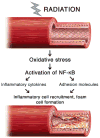Understanding radiation-induced vascular disease
- PMID: 20298931
- PMCID: PMC3807611
- DOI: 10.1016/j.jacc.2009.11.053
Understanding radiation-induced vascular disease
Abstract
Radiation injury of blood vessels was originally described more than a century ago and remains a contemporary clinical problem, despite dramatic advances in the field of radiation oncology (1). Clinical studies indicate that patients who have previously undergone radiation therapy for various malignancies—such as lymphoma, breast cancer, and head and neck cancer—are at increased risk for developing vascular disease (2). The consequences are significant; depending upon the study, the relative risk of suffering a clinical cardiovascular event (i.e., myocardial infarction, stroke) related to radiation therapy ranges from approximately 1.5- to 4.0-fold, and this risk is further amplified in the presence of traditional cardiovascular risk factors (3,4).
Figures
Comment on
-
Sustained inflammation due to nuclear factor-kappa B activation in irradiated human arteries.J Am Coll Cardiol. 2010 Mar 23;55(12):1227-1236. doi: 10.1016/j.jacc.2009.10.047. J Am Coll Cardiol. 2010. PMID: 20298930
References
-
- Fajardo LF, Berthrong M. Vascular lesions following radiation. Pathol Annu. 1988;23(Pt 1):297–330. - PubMed
-
- Russell NS, Hoving S, Heeneman S, et al. Novel insights into pathological changes in muscular arteries of radiotherapy patients. Radiother Oncol. 2009;92:477– 83. - PubMed
-
- Fajardo LF. Is the pathology of radiation injury different in small vs large blood vessels? Cardiovasc Radiat Med. 1999;1:108–10. - PubMed
-
- Hooning MJ, Botma A, Aleman BM, et al. Long-term risk of cardiovascular disease in 10-year survivors of breast cancer. J Natl Cancer Inst. 2007;99:365–75. - PubMed
-
- Jurado JA, Bashir R, Burket MW. Radiation-induced peripheral artery disease. Catheter Cardiovasc Interv. 2008;72:563– 8. - PubMed
Publication types
MeSH terms
Grants and funding
LinkOut - more resources
Full Text Sources
Other Literature Sources
Medical


